To manage erosion in resin-bound gravel on slopes, first assess the slope’s steepness. Establish a solid base with a permeable sub-base, using angular aggregates for better grip. Install effective drainage solutions, like interlocking channel drains, to redirect excess water. When installing, work upwards and apply thicker layers on steeper sections for added durability. Also, plan for regular maintenance and consider eco-friendly options. There are various effective methods for managing erosion that can be explored further.
Key Takeaways
- Assess the steepness of the slope and implement stronger erosion control measures for gradients over 5% to reduce runoff and soil erosion.
- Establish a solid base using angular aggregates and a permeable sub-base to improve grip and drainage efficiency.
- Install drainage channels along the slopes to redirect water and prevent erosion, ensuring they are appropriately sized for the anticipated flow.
- Regularly inspect and maintain surfaces by sweeping and using low-pressure washing to keep them clear and functional.
- Incorporate native plants and natural materials to stabilise slopes, enhance visual appeal, and support local wildlife.
Proper Slope Assessment for Erosion Control
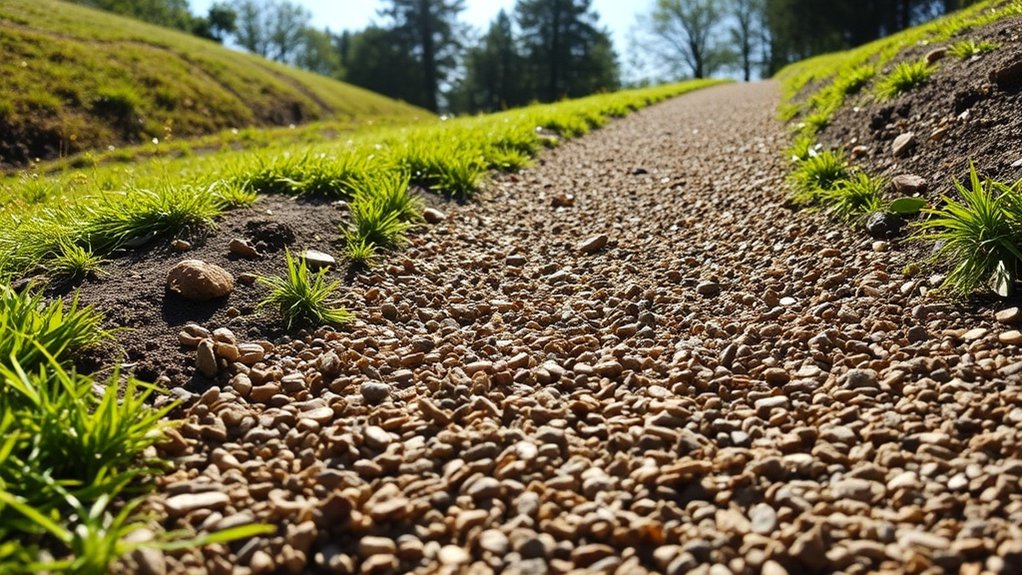
When assessing slopes for erosion control, it’s crucial to recognise how steepness and gradient affect erosion risk. A thorough slope assessment helps identify gradients; slopes steeper than 5% often need stronger erosion control measures. For longer slopes, particularly those over 15 metres, the increased volume and speed of runoff can heighten erosion potential. Consider using the Revised Universal Soil Loss Equation (RUSLE) to estimate soil loss based on slope steepness and other factors.
Additionally, recognizing the impact of erosion is essential for developing effective mitigation strategies and ensuring the longevity of the construction project. Adjusting slope geometry through grading techniques can create a more erosion-resistant slope by reducing steepness where feasible. Properly managing aggressive rainwater runoff is vital in preserving the stability of the slope and preventing further erosion issues.
Creating a Solid Base to Prevent Erosion
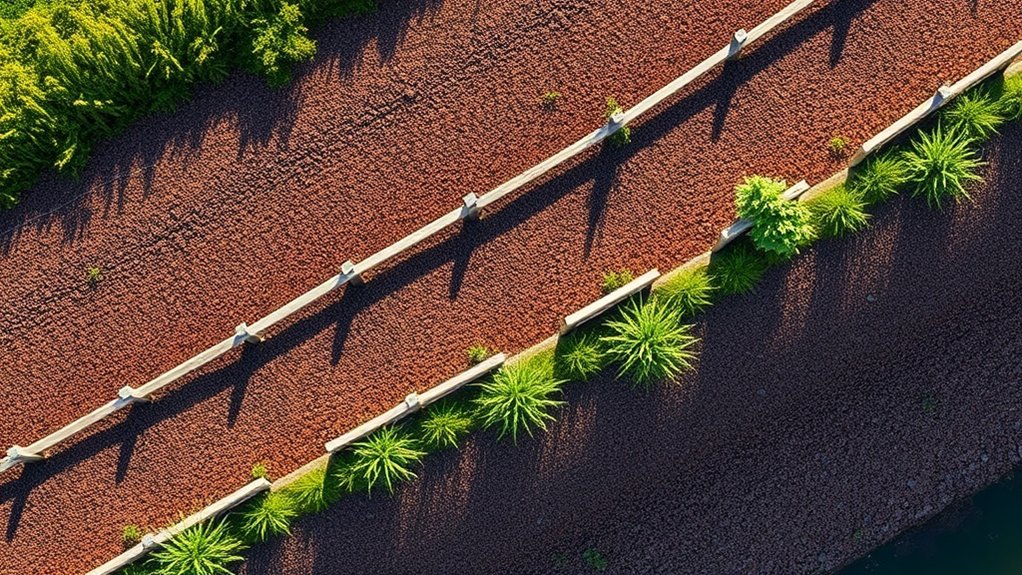
Creating a solid base is crucial for preventing erosion in resin-bound gravel applications. Start by removing any existing surfaces and excavating to a depth of at least 220mm, adjusting based on site conditions.
Ensure the excavation is wider than planned to accommodate edge restraints, which will provide additional stability and help resist lateral movement.
Next, lay a permeable sub-base using MOT Type 3 hardcore at a minimum depth of 150mm, compacting it well for maximum stability. The type of sub-base significantly impacts installation success and durability, ensuring the longevity of the surface.
Avoid placing granular sub-bases directly under the resin surface; instead, a rigid base like concrete is essential for effective erosion prevention.
Before applying the resin, check the moisture levels of the surface and clean it thoroughly to ensure strong adhesion, providing long-lasting protection against erosion. Additionally, implementing suitable drainage channels can further enhance the effectiveness of your base in managing water flow and preventing erosion.
Selecting the Right Aggregates for Stability
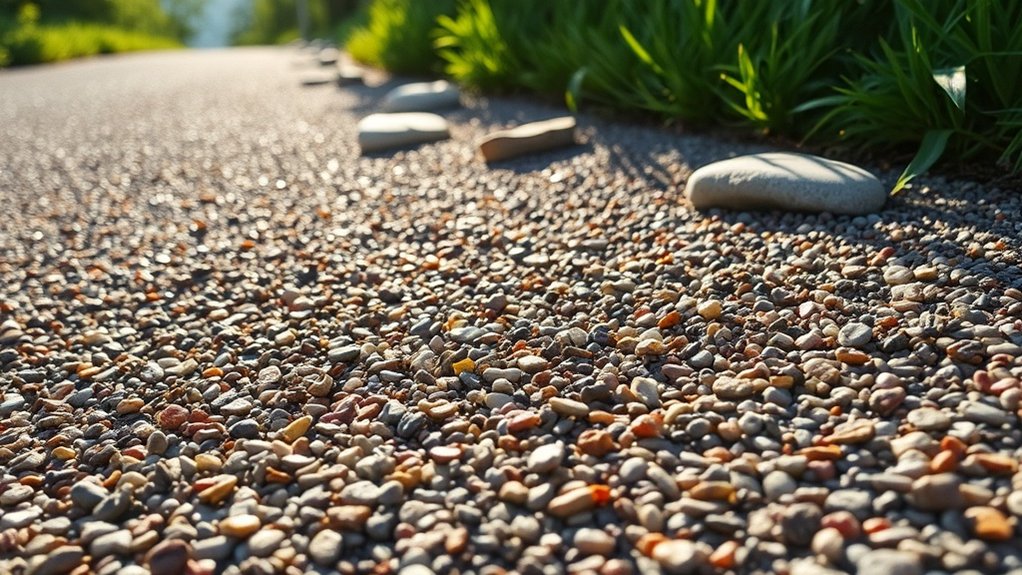
Once you’ve established a solid base, the next step is to choose the right aggregates for stability in resin-bound gravel systems.
Opt for angular stones sized 2-5mm, as they provide excellent grip on slopes, much like winter tyres. Ensure the texture enhances traction, especially in wet conditions, while allowing for efficient drainage. This is essential because resin-bound gravel acts like a permeable sponge, allowing for effective rainwater management. Proper grading of the aggregates is also vital for ensuring a tighter fit, which contributes to the overall strength and durability of the surface.
It’s crucial that the aggregates are compatible with the resin binder to ensure strong bonding and prevent deterioration.
Select eco-friendly aggregates from sustainable sources to align with environmental goals.
Also, consider factors such as load-bearing capacity and chemical resistance for long-lasting performance.
Lastly, pick aggregates that are visually appealing and blend well with your landscape, enhancing both functionality and appearance while minimising maintenance needs.
Effective Drainage Planning for Slopes
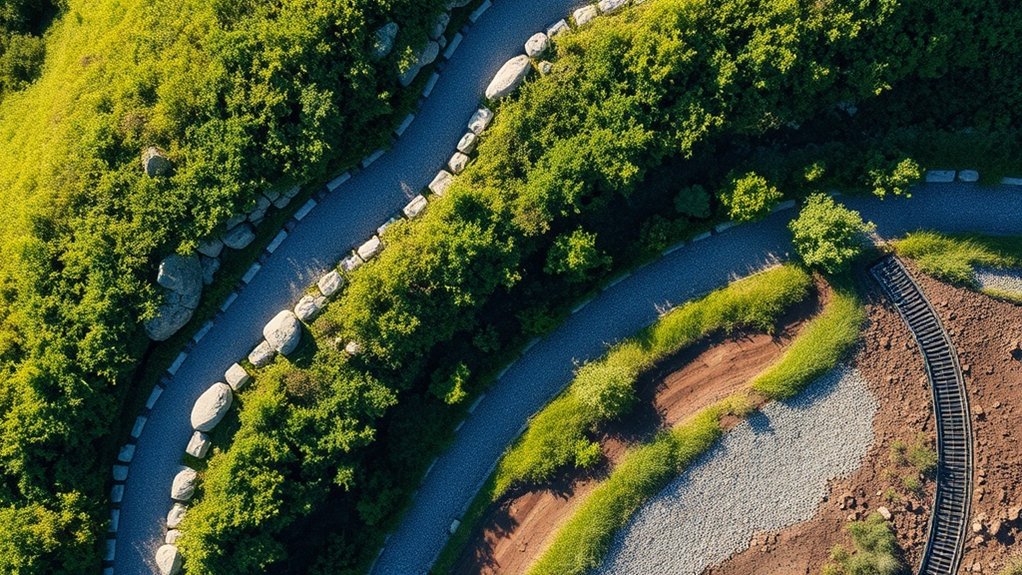
Effective drainage planning for slopes is crucial, as poor management can cause erosion and surface damage. Start by installing drainage channels along the edges of slopes to capture and redirect excess water, which helps prevent puddling.
Opt for interlocking channel drains with grates for secure fitting and straightforward installation. Ensure the channels are properly sized to handle expected water volumes based on the slope’s gradient.
Incorporate a permeable sub-base, such as open graded porous tarmac, to encourage water infiltration and improve your drainage system. Grade surfaces to facilitate gradual drainage, steering clear of areas where water could accumulate and cause erosion.
Regularly inspect and clear debris from the channels to maintain their efficiency, ensuring effective erosion control and safeguarding your resin-bound surfaces.
Installation Techniques to Minimize Erosion
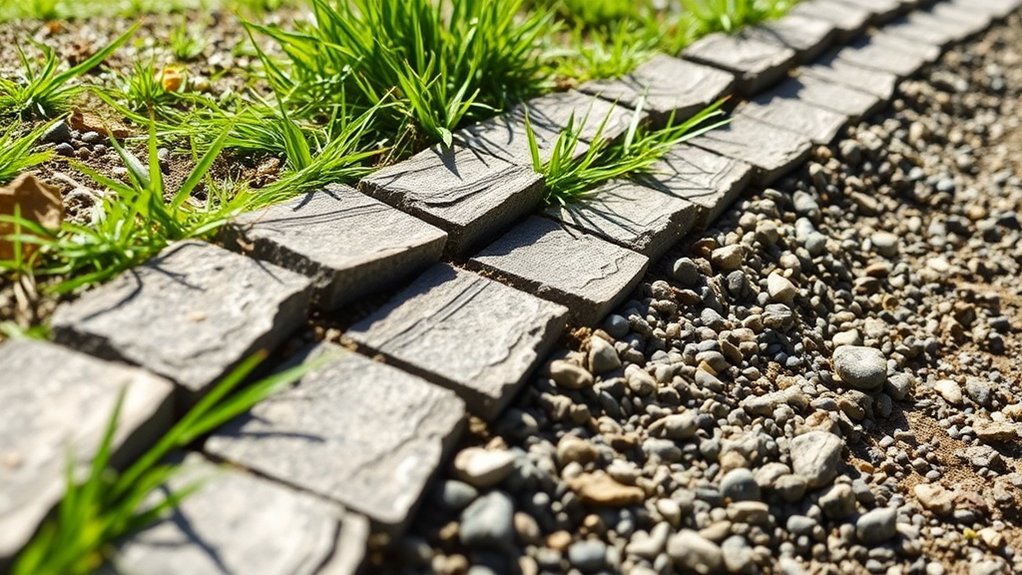
When installing resin-bound gravel, use the working upwards technique to ensure proper adhesion and stability on slopes.
Applying thicker layers in steeper areas enhances durability and significantly reduces the risk of erosion.
This method not only strengthens your installation but also aids in effective water management across the surface.
Working Upwards Technique
To ensure proper installation of resin-bound gravel on slopes and reduce erosion, it’s crucial to start at the top and work your way down. This method helps keep edges fresh and achieves a smooth finish.
Here are some essential tips to consider:
- Begin pouring at the highest point to avoid treading on fresh areas.
- Progressively move down the slope for better control and placement.
- Pour in manageable batches for even spreading.
- Use a flat trowel for consistent levelling before moving on.
- Avoid walking backwards on wet resin to prevent disruptions.
Thicker Layers Application
Achieving a durable resin-bound gravel surface on slopes requires the application of thicker layers, which helps reduce erosion risks and enhances stability. By using high-viscosity resin and ensuring proper aggregate interlock, you can create a strong installation. Here’s a simple guide:
| Step | Action | Importance |
|---|---|---|
| Surface Inspection | Check for cracks and weaknesses | Prevents future erosion |
| Base Creation | Use a well-compacted sub-base | Enhances slope stability |
| Priming | Apply a suitable primer | Ensures strong adhesion |
| Drainage Consideration | Implement proper grading | Directs water runoff |
| Batch Consistency | Mix resin and aggregates evenly | Maintains layer integrity |
Enhancing Permeability and Drainage Solutions
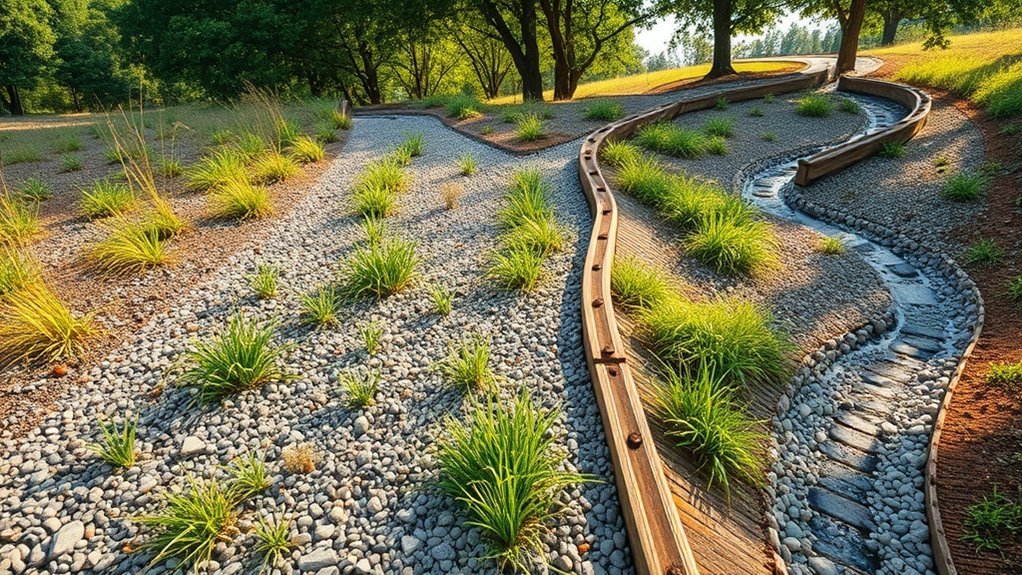
To improve permeability and drainage in resin-bound gravel, focus on creating effective drainage pathways for free water flow.
Using permeable resin surfaces alongside proper slope maintenance can significantly reduce erosion risks and enhance water management.
Effective Drainage Pathways
Effective drainage pathways are vital for managing erosion in resin-bound gravel surfaces, particularly when rainwater runoff threatens their stability.
Here are some strategies to enhance your drainage design and surface water management:
- Install drainage channels and edge drains to collect excess runoff.
- Maintain a gentle slope of 1-2% to encourage proper water flow.
- Use high-quality, porous sub-base materials for better permeability.
- Regularly clear debris to avoid blockages in your drainage systems.
- Align your approach with Sustainable Drainage Systems (SuDS) principles for environmentally friendly runoff management.
Permeable Resin Surfaces
Traditional paving materials often struggle with water management, but permeable resin surfaces excel in this area. These surfaces are fully permeable, allowing water to pass through tiny gaps between resin-coated aggregates, which significantly reduces puddling and surface water build-up.
By using angular, graded stones with a minimal resin-to-aggregate ratio, you ensure optimal permeability, improving overall performance.
The environmental benefits are noteworthy; these surfaces help recharge groundwater and reduce flood risks, all while adhering to sustainability regulations.
With proper installation and maintenance, permeable resin-bound gravel offers a durable and attractive solution that complements your landscape and supports eco-friendly practices.
Consistent Slope Maintenance
Consistent slope maintenance is vital for improving permeability and ensuring effective drainage in resin-bound gravel surfaces.
Here are some key practices to enhance slope stability and prevent erosion:
- Regularly sweep with stiff brooms to keep surfaces clear of debris and maintain permeability.
- Use low-pressure washing techniques to clean without dislodging the aggregates.
- Avoid placing heavy loads on the surface to maintain its structural integrity.
- Check for loose stones regularly and address them promptly to prevent damage.
- Adopt long-term maintenance strategies, such as periodic sealing and drainage inspections.
Integrating Anti-Slip Features for Safety
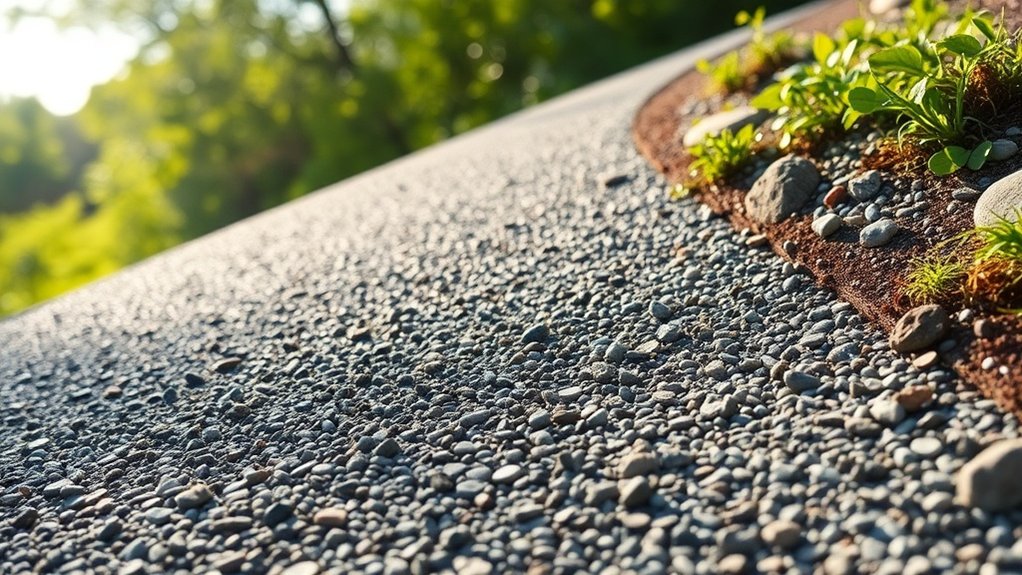
When adding anti-slip features to resin-bound gravel surfaces, it’s important to balance safety and appearance.
For slopes, choose anti-slip aggregates like crushed glass, which improve slip resistance without detracting from the visual appeal. These aggregates provide a natural texture that offers a “sandpaper-like” grip, ensuring stability in wet conditions.
You might also want to consider non-slip coatings for added safety. With design flexibility, you can create attractive patterns and colours that enhance the overall look while prioritising safety.
Long-Term Maintenance Strategies to Combat Erosion
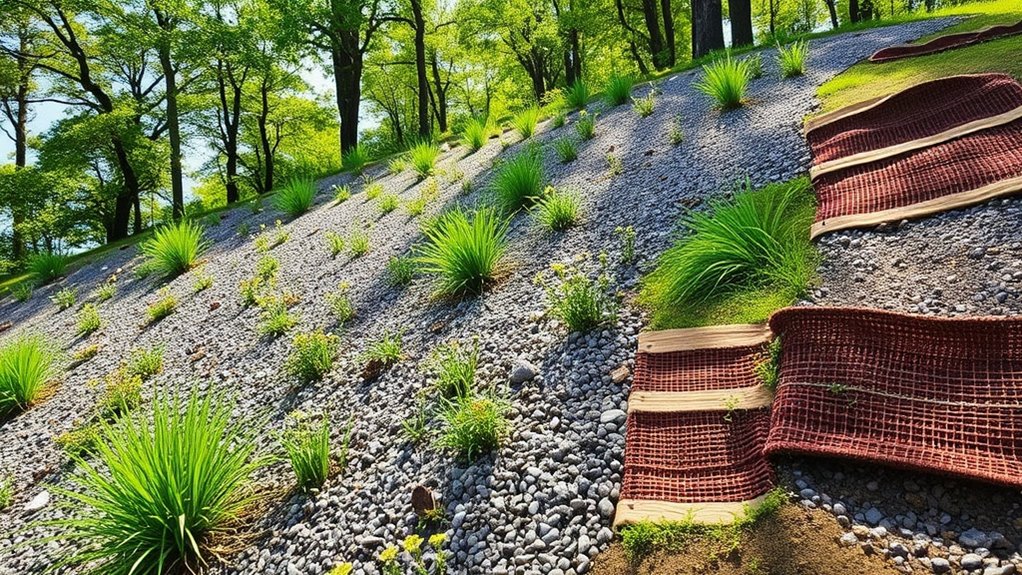
To effectively tackle erosion on resin-bound gravel surfaces, a proactive long-term maintenance strategy is vital. This not only extends the life of the resin but also helps manage your maintenance costs.
Here are key strategies to consider:
- Carry out annual inspections to catch any damage early.
- Regularly clean the surface and remove debris.
- Ensure proper drainage to manage water runoff.
- Use eco-friendly de-icers in winter.
- Plan for resealing every 2 to 5 years with UV-resistant sealants.
Environmental and Aesthetic Considerations in Erosion Management
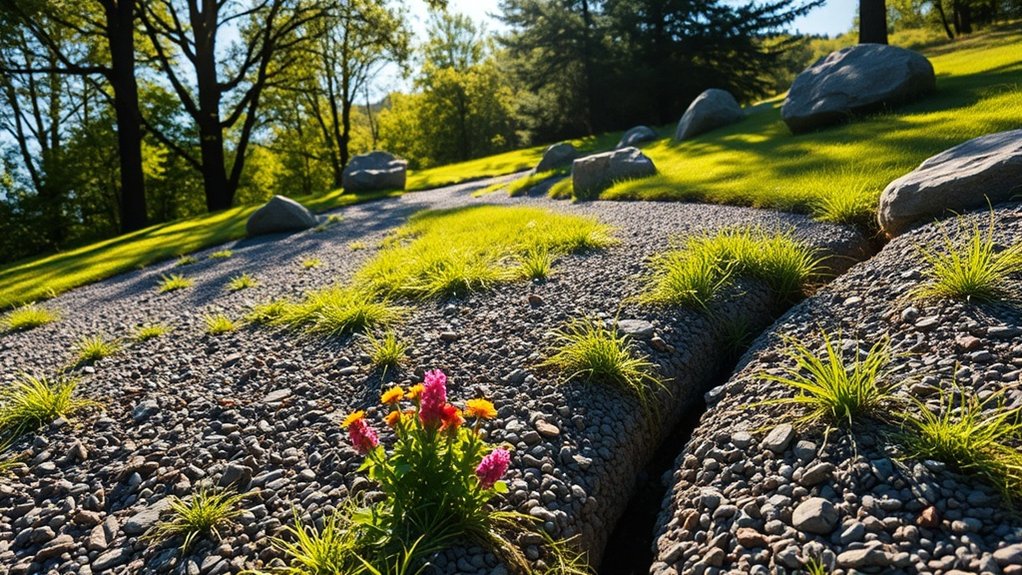
Erosion management isn’t just about stopping soil loss; it’s also about working with the environment and improving visual appeal. Incorporating native plants into your erosion control plans not only strengthens slope stability but also supports local wildlife.
Opt for a variety of deep-rooted species that quickly cover the ground and enhance water absorption. Use natural materials such as stones and erosion control mats to create barriers that blend well with the landscape, ensuring visual harmony.
Designing terraces and following the contours of the land mimics natural forms, enhancing the overall look. Lastly, take into account local climate and seasonal changes to ensure your methods are effective and environmentally friendly, leading to a sustainable and attractive approach to erosion control.
Frequently Asked Questions
How Do Weather Conditions Affect Resin-Bound Gravel Durability?
Weather conditions have a significant impact on the durability of resin-bound gravel. High temperatures can cause the resin to soften, leading to potential wear and damage. Conversely, freeze-thaw cycles can compromise its structural integrity. To mitigate these effects, proper installation and regular seasonal maintenance are essential. This approach ensures the gravel remains resilient, even in challenging weather conditions.
Can Resin-Bound Gravel Be Repaired if Damaged?
Yes, resin-bound gravel can be repaired. Techniques such as applying a new layer and feathering the edges can effectively address any damage. Regular maintenance helps keep your surface looking good and extends its lifespan, ensuring your outdoor area remains attractive and functional.
What Tools Are Essential for Resin-Bound Gravel Installation?
For installing resin-bound gravel, you’ll need trowels, screed sledges, heavy-duty mixers, and mixing buckets. It’s also important to have maintenance gear like cleaning rags, gloves, and safety goggles to ensure safety and efficiency during the job.
How Do I Choose the Right Resin Type?
To select the right type of resin, assess key properties such as flexibility and UV resistance. For instance, if you’re working on outdoor furniture, choose a resin that can withstand sunlight. Ensure that the chosen resin is compatible with your project’s conditions to guarantee optimal performance and durability.
What Is the Lifespan of Resin-Bound Gravel Surfaces?
Resin-bound gravel surfaces generally last between 15 to 30 years, influenced by the quality of the resin and the level of maintenance. Regular cleaning and resealing can significantly extend their lifespan, keeping them looking attractive for longer. For instance, just like you would care for a driveway or patio, a bit of routine upkeep goes a long way in preserving the beauty of your resin-bound surface.
Conclusion
Managing erosion in resin-bound gravel on slopes is crucial, as around 25% of all soil erosion occurs in these areas. To mitigate erosion, start with a thorough slope assessment, choose suitable aggregates, and ensure proper drainage. Regular maintenance is key; it not only enhances safety but also extends the lifespan of your installation. For example, adding anti-slip features can prevent accidents during wet weather. By implementing these strategies, you can create a stable and attractive environment that will endure over time.
